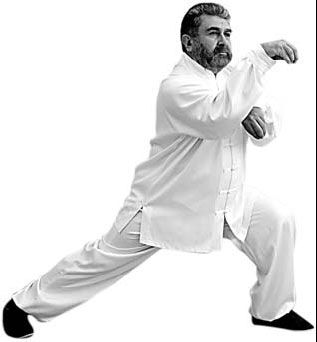Channeling the flow across borders
Chilean Luis Pedreros traveled halfway across the world and then carried his heavy suitcase on his back walking for more than 40 km - all in the name of taichi. His destination is Chenjiagou, a village at Wenxian county of Henan province, which was believed to be the cradle of Chen-style taichi.
That was 15 years ago, and today, Pedreros' passion is as strong as ever. To study true qigong from real masters, Pedrero came to Beijing's Chinese Health Qigong Association ahead of the Spring Festival this year.
The president of Chilean Wushu Federation and director of Latin American Lohan Qigong says taichi and qigong are very popular in Chile and other Western countries. "Internet and TV enable us to learn about China and its culture. When we see that Chinese keep slim by drinking tea, we drink tea. When we see the aged Chinese keep healthy by practicing taichi and qigong, we also try."
Attracted by magazines and films about Chinese kung fu when he was a boy, Pedreros followed Chinese masters to study taichi and qigong in Chile and Australia.
|
Luis Pedreros practices taichi. Courtesy of Luis Pedreros |
Introduced by one of his masters in Australia, he journeyed to Chenjiagou 15 years ago when he was 42. "They were all kind to me. But we couldn't communicate, so I could only follow my master's actions," says Pedreros, recalling that three noodle dinners a day and simple toilets were the biggest troubles for him.
"The Westerners are really fond of taichi and qigong, and there are a lot of kung fu schools and gyms to teach these. However, it is hard to find true masters," says Pedreros, whose federation has hundreds of member clubs in Chile.
When he taught taichi in Australia in the early 1980s, a student asked him whether taichi was a Chinese food. When he met a "taichi instructor" several years ago, the woman was performing Ba Duan Jin, a kind of qigong.
"Maybe taichi is more famous in Western countries. However, many people have practiced qigong for many years, but they don't know it," Pedreros says.
"In my view, taichi is a general formula for people's health, but qigong is a special formula that can have special effects on different body parts," he says.
He cites a student who suffered from insomnia.
"Taichi didn't take effect on him, because it was a series of movements, which frustrated him more. Then I taught him just one qigong posture, and his problem was solved.
"Compared to taichi, qigong is simpler and easier to remember," says Pedreros, who also has studied traditional Chinese medicine at Guangzhou University of Chinese Medicine.
Speaking some so-called qigong groups that even drive people to commit suicide, Pedreros says: "The truth is that most Westerns laugh at them. Qigong is good, but some people are bad. They ruined qigong by making use of qigong for bad purposes, for money, for their pocket. "
Having been to China 30 times, Pedreros witnessed China's changes over the past two decades.
"When some of my Chilean friends came to China for the first time, they asked me why Chinese buildings had no tiled roofs like in the films. They were surprised at seeing Chinese using computers instead of writing with brushes," he says.
"So there is much more we can do to improve mutual understanding. I hope I can introduce the true qigong to Latin America."
(China Daily 02/05/2008 page20)















